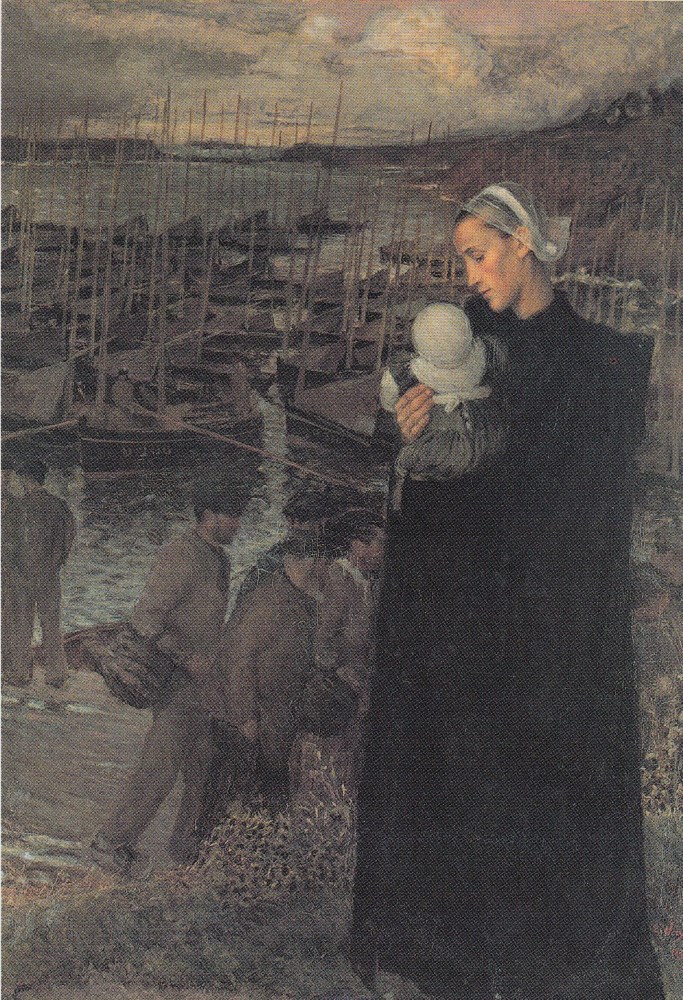Description:
Emile Wéry (1868-1935) studied at the Académie Julian. He was friends with the fowist, H. Matisse, occupying two adjacent studios in Montparnasse in Paris. In 1896 they took a trip together to Brittany. This is where Wéry‘s love for realistic representations of everyday life in this region came from. He also dealt with decorative mural painting, however his Breton paintings were the ones most often rewarded.
Description of the painting:
In the foreground of the painting is a mother in traditional Breton dark clothing with a bonnet on her head, holding a child in her arms. In the background, fishermen are returning from fishing, and the title of the painting suggests that this was an exceptionally dangerous day. The mother looks at the child with calmness, but her face also shows worry, fatigue, and even resignation. Perhaps she has been waiting for her husband to return from fishing for a long time. The painting “Evening after the Storm“ should be compared to the similarly located, on the other side of the passage to the next hall, the painting “Mother“ by Jules Adler.
Two images by two different representatives of the “Black Band“ in the Rogalińska Gallery are in the same room, even hung on the same wall. Both depict the figure of a mother holding a child, but in a very contrasting manner. The canvases were highly rated by critics and selected for a retrospective Universal Exhibition in Paris in 1900.
Jules Adler was a realistic painter. In addition to representations of Brittany, he showed almost journalistic reports from everyday life of the working class and snapshots of French streets. The composition of the painting titled “Mother“ evokes a photographic frame. It seems to be a random capture of the moment of the action taking place in the city space. The titular mother with a child in her arms and a large package quickly strides through the street. Behind her, in the background, the men crowded in the bar drink absinthe. The painting is dominated by a brown, monochromatic color scheme. Against it stands out the brighter figure of the child, as one that the dust, grayness and the hustle and bustle of city life has not yet dominated.
The author of “Evening After the Storm“ gained the most fame for his naturalistic depictions of Breton themes. This love of the everyday life of the people of the peninsula was born in É.A. Wéry during one of his trips to Brittany in the company of his friend, the fowist Henri Matisse. In the painting presented today, a mother with a child in her arms is shown in the foreground. The canvas, like Adler‘s “Mother“, is kept in a dark color scheme. Attention is drawn to the distinctive, bright face of the woman. She looks at her child with an expression of anxiety, exhaustion, and perhaps resignation. Her melancholy face matches the surrounding scenery: a cloudy sky, lonely boats crowded in the port, abandoned by fishermen returning after a dangerous and probably unsuccessful fishing trip back home. Perhaps the mother with the newborn child, as soon as the storm subsided, went out to see if her husband had managed to return.
Two images, two women, two worlds. On one side a poor working woman, hurrying through the streets of a crowded city, on the other – a mother lost in melancholy, routine, living on the edge of Brittany, in a poor fishing village by the ocean. The contrast of two different scenarios raises reflections on the lifestyle, its urban pace, the struggle with the difficult everyday life and the all–encompassing nature, to which the inhabitants of the fishing village completely submitted, accepting the order imposed by it.


